Sejamos honestos: os honorários de consultoria podem parecer o oeste selvagem dos gastos corporativos.
Você tem empresas de primeira linha cobrando diárias altíssimas, consultorias de butique faturando como se fossem a McKinsey e stakeholders internos insistindo, "Precisamos deles - eles são os únicos que entendem nosso negócio." Parece familiar?
Se você trabalha com compras, finanças ou liderança estratégica, provavelmente já se deparou com essa pergunta: Como podemos reduzir os custos de consultoria sem perder o valor que essas empresas oferecem? Porque, convenhamos, os consultores não são apenas caros, eles geralmente são de missão crítica.
Eles apoiam programas de transformação de alto risco, aceleram iniciativas digitais e trazem conhecimentos especializados difíceis de encontrar quando o tempo é essencial. A última coisa que você quer é cortar os custos de forma tão agressiva que acabe tendo um impacto diluído, parceiros desinteressados ou, pior ainda, fracassos de consultoria que custam mais caro para a empresa no longo prazo.
A boa notícia? Você não precisa escolher entre economizar dinheiro e entrega de valor.
Este artigo é seu manual para fazer as duas coisas. Vamos explorar:
- De onde realmente vêm os custos de consultoria (spoiler: não é apenas o cartão de tarifas)
- As maneiras mais inteligentes de negociar, definir o escopo e gerenciar os contratos de consultoria
- Como evitar as armadilhas que fazem com que a "economia" desapareça após o projeto
- E por que as ferramentas digitais - especialmente as plataformas específicas por categoria - são um divisor de águas para controlar os gastos com consultoria
Você também receberá dicas de especialistas de líderes de compras do mundo real que passaram por essa corda bamba e encontraram o equilíbrio - e a economia - sem sacrificar o desempenho.
Vamos nos aprofundar no que torna a consultoria tão cara - e onde estão as oportunidades reais.
I. Entendendo o custo real da consultoria
Quando falamos em reduzir os custos de consultoria, o primeiro instinto geralmente é focar em taxas.
"Podemos fazer com que eles reduzam a taxa diária?"
"Eles estão cobrando mais do que a média do mercado?"
"Devemos renegociar esse contrato?"
Essas perguntas são justas, mas apenas arranham a superfície. Como a custo real da consultoria não se trata apenas de quanto uma empresa cobra por dia. Trata-se de tudo que envolve esse número: como o projeto é definido, gerenciado e entregue.
Vamos desvendar as camadas.
A. A ilusão do cartão de tarifas
É claro que as tarifas diárias são importantes. Mas comparar taxas entre empresas sem entender o contexto é como comparar quartos de hotel apenas pelo preço, sem verificar a localização, as comodidades ou se o café da manhã está incluído.
Duas empresas podem oferecer taxas diárias muito diferentes, mas o que realmente importa é:
- Quantos dias eles realmente passarão
- Com quais resultados eles estão se comprometendo
- Quanto valor eles gerarão para a empresa
Uma empresa que cobra € 6.000/dia, mas que conclui um projeto em quatro semanas com insights transformadores, pode ser um negócio melhor do que uma empresa que cobra € 3.500/dia, que leva três meses e entrega um slideware.
Principais conclusões: Não otimize para taxas diárias - otimize para resultados.
B. Custos ocultos que provavelmente não estão sendo monitorados
Vamos falar sobre os custos sorrateiros que não aparecem no contrato, mas que atingem seu resultado final de qualquer maneira.
🔸 Deslocamento do escopo
Aquela frase inocente "Podemos acrescentar mais uma entrevista?" muitas vezes se transforma em semanas extras de trabalho e dezenas de milhares em custos não planejados. Sem limites claros e sem um processo de ordem de mudança, o desvio de escopo é um assassino silencioso do orçamento.
🔸 Dreno de tempo interno
Quando seus executivos passam horas gerenciando os consultores, revisando os resultados ou preenchendo lacunas, esses são custos ocultos. O tempo FTE interno tem valor - e se um consultor precisa de muita atenção, você não está economizando dinheiro, está transferindo custos.
🔸 Custos de oportunidade
Digamos que um consultor apresente uma apresentação de boa aparência, mas as recomendações não sejam acionáveis - ou pior, estejam desalinhadas com os recursos internos. Isso não é apenas um projeto ruim. Isso é um atraso em seu roteiro estratégico. Esse é um tempo que você não recupera
C. A história: A pechincha de 200 mil euros que custou 2 milhões de euros
Uma empresa europeia de serviços financeiros contratou uma empresa de consultoria especializada pelo que parecia ser uma pechincha: 200.000 euros para avaliar sua estratégia de fornecedores de TI. O escopo era vago, mas o preço era baixo.
Seis meses depois, após duas reavaliações, cinco gerentes de projeto diferentes e nenhuma recomendação implementada, eles perceberam que o projeto "barato" havia sido abandonado:
- Desperdício de largura de banda dos executivos
- Atraso em um plano de transformação interna
- Solicitou outra empresa para consertar a bagunça
Custo total? Mais de 2 milhões de euros em valor perdido. O que começou como uma iniciativa de economia tornou-se uma lição cara de falsa economia.
D. Por que é importante
Entender o verdadeiro custo da consultoria significa sair das taxas para valor total entregue. Trata-se do ciclo de vida do projeto, do suporte interno necessário e do impacto comercial que permanece após a conclusão dos slides.
Se você conseguir identificar esses custos ocultos antecipadamente, já estará a meio caminho de uma economia mais inteligente.
II. Principais estratégias para reduzir os custos de consultoria
Uma vez que você tenha entendido o verdadeiro custo da consultoria, a próxima pergunta é: Onde podemos realmente economizar, sem enfraquecer os resultados?
Aqui estão cinco estratégias de alto impacto usadas pelas equipes de estratégia e de compras com melhor desempenho para reduzir os gastos e maximizar o valor.
A. Negocie de forma mais inteligente, não apenas com mais afinco
Negociar não significa reduzir seus fornecedores a pó - trata-se de estruturar um acordo que funcione para todos.
É claro que você pode pressionar por taxas diárias mais baixas. Mas os maiores ganhos vêm da negociação:
- Modelos de taxa fixa: Transferir o risco para o consultor, concordando com o preço baseado em valor.
- Pagamentos de marcos: Associe os pagamentos aos resultados, não apenas ao tempo gasto.
- Descontos por volume ou exclusividade: Se você estiver se comprometendo com vários projetos ou com um modelo de parceiro preferencial, use isso como vantagem.
Dica profissional: Sempre faça benchmarking. Use inteligência de mercado ou ferramentas como os dados de desempenho de fornecedores da Consource.io para garantir que as taxas e estruturas estejam alinhadas com as práticas recomendadas.
B. Alavancar relacionamentos de longo prazo
A consultoria é um negócio de pessoas. Se você já trabalhou com uma empresa antes - e ela cumpriu o prometido -, não comece do zero todas as vezes.
O desenvolvimento de relacionamentos com fornecedores preferenciais pode ser desbloqueado:
- Melhores preços para negócios recorrentes
- Tempo de implantação mais rápido (eles já entendem sua organização)
- Mais participação no jogo, porque a empresa sabe que está sendo avaliada em vários compromissos
A ressalva? Não deixe que a familiaridade gere complacência. Meça os resultados. Acompanhe o valor. Recompense o desempenho.
C. Escopo inteligente, escopo implacável
É aqui que a maioria dos custos excedentes começa: escopos de trabalho vagos.
Um bom escopo de projeto deve definir claramente:
- Objetivos (Qual é o problema que estamos resolvendo?)
- Entregáveis (O que receberemos, em que formato?)
- Linha do tempo (Quando veremos os resultados?)
- Inclusões/Exclusões (O que é não parte disso?)
Se você não fizer isso, estará deixando a porta aberta para o aumento do escopo e para custos excessivos.
Dica profissional: Insista nos compromissos de escopo da "Fase 0" quando os riscos forem altos. Um pequeno investimento inicial para co-projetar o escopo pode economizar milhares mais tarde.
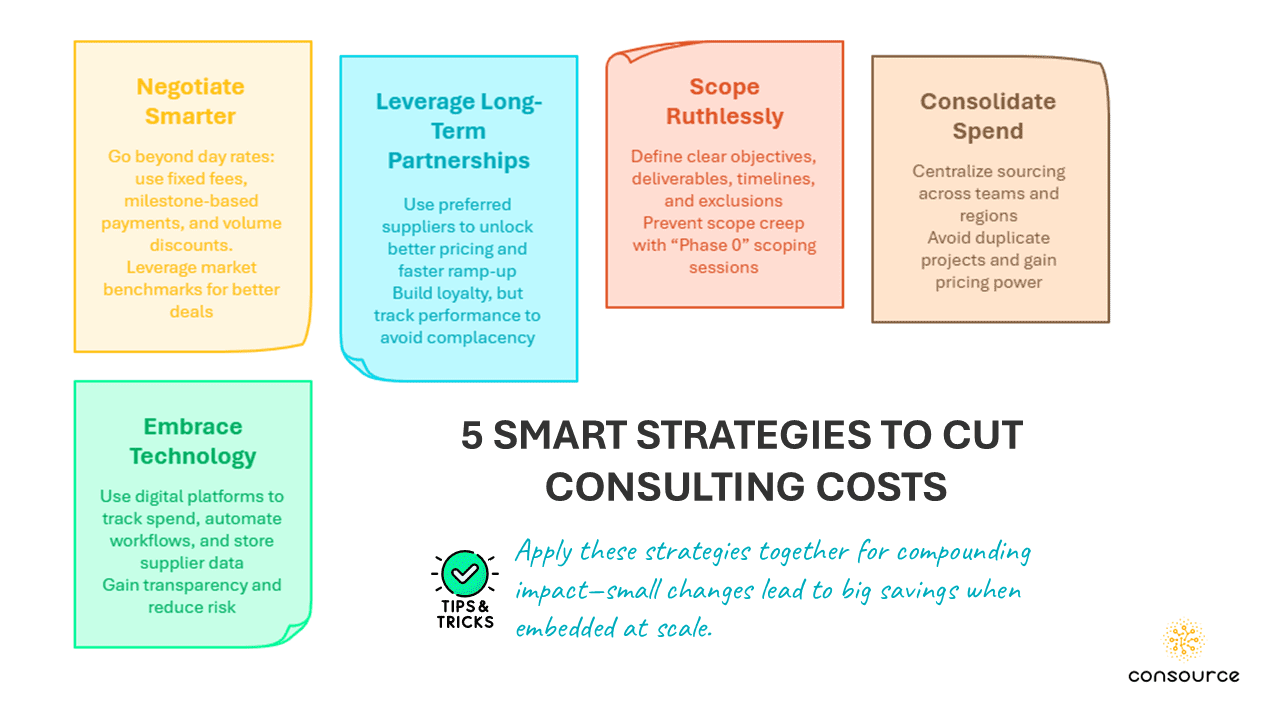
D. Consolidar seus gastos
Os gastos com consultoria geralmente são fragmentados entre departamentos, países e categorias.
Isso dificulta sua identificação:
- Esforços duplicados (duas equipes contratando empresas para a mesma análise)
- Oportunidades perdidas de economia com pacotes
- Tendências no desempenho dos fornecedores em toda a empresa
Quando você consolida as despesas por meio de uma plataforma centralizada ou de um líder de categoria, você desbloqueia a alavancagem de preços e obter supervisão estratégica.
Melhor ainda? Você pode começar a identificar espaços em branco - áreas em que a capacidade interna poderia substituir totalmente os gastos externos.
E. Adote a tecnologia para promover a transparência
As ferramentas digitais transformaram a logística, o RH e o marketing - então, por que a aquisição de consultoria ainda está presa a planilhas?
Com a plataforma certa, você pode:
- Acompanhe os gastos e o desempenho do projeto em tempo real
- Aplicar processos padronizados de sourcing
- Armazenar dados históricos de fornecedores e referências de taxas
- Automatize aprovações, NDAs e conformidade com contratos
Isso não reduz apenas os custos. Reduz os riscos. E transforma a aquisição de consultoria em uma função proativa e orientada por insights.
III. Armadilhas comuns a serem evitadas
Então você negociou as taxas, definiu o escopo do projeto e assinou o contrato. Você está se sentindo bem. Mas então... as rachaduras começam a aparecer.
Até mesmo a melhor estratégia de economia de custos pode ir por água abaixo se você tropeçar nessas armadilhas clássicas. Vamos examinar as principais armadilhas da aquisição de consultoria - e como evitá-las como um profissional.
A. Buscando o preço mais baixo (e pagando o custo mais alto)
Todos nós já vimos isso: uma empresa oferece uma taxa significativamente mais baixa, e alguém lá em cima diz, "Vamos escolher o mais barato - é apenas uma pesquisa de mercado, certo?"
Mas o problema é o seguinte: quando você otimiza apenas para o preço, muitas vezes está negociando:
- Experiência (eles não fizeram isso 50 vezes antes)
- Velocidade (mais tempo de aceleração, mais controle manual)
- Impacto (insights genéricos em vez de estratégia personalizada)
Consultoria barata pode se transformar em projetos de recuperação dispendiosos. Sempre considere valor total entreguee não apenas o preço de etiqueta.
Regra geral: Se parecer bom demais para ser verdade, provavelmente significa mais esforço interno ou resultados de qualidade inferior.
B. Subestimando o custo de um gerenciamento de projetos ruim
Os consultores não são do tipo "plug-and-play". Até mesmo as melhores empresas precisam:
- Um tomador de decisões claro
- Acesso oportuno a dados e partes interessadas
- Pontos de verificação estruturados para validar a direção
Quando ninguém está dirigindo ativamente o navio, os consultores podem se desviar do curso ou entregar algo de que a empresa não precisa mais.
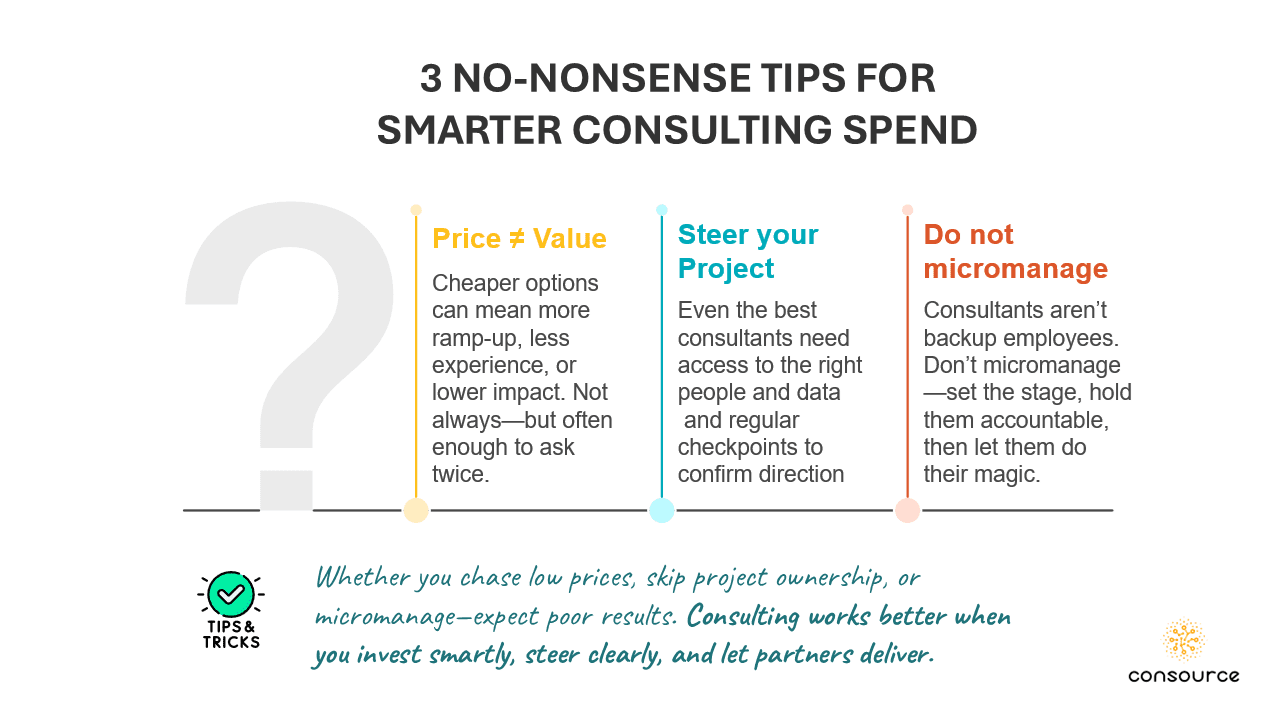
C. Tratamento de consultores como equipe interna (em vez de parceiros)
Esse é um ponto importante. Muitos projetos de consultoria são interrompidos porque o cliente tenta gerenciar consultores como funcionários-com verificações constantes, edição linha por linha ou, pior, fazendo metade do trabalho por eles.
Os consultores não estão lá para serem microgerenciados. Eles estão lá para produzir resultados. Se não estiverem fazendo isso, trata-se de um problema de fornecimento ou de responsabilidade - e não de uma solução de "mais reuniões".
Seu trabalho é:
- Estabelecer as condições certas para o sucesso (acesso, clareza, suporte)
- Responsabilize-os pelo escopo e pelos marcos
- Afaste-se e deixe que eles próprio entrega
Seu trabalho é: trazer o conhecimento, conduzir o trabalho e entregar resultados - não se tornar parte da reunião diária da equipe.
O resultado final? O custo desses erros é real: orçamento desperdiçado, tempo perdido e resultados insatisfatórios. Mas a boa notícia? Eles podem ser totalmente evitados com a mentalidade e a estrutura corretas.
IV. Criação de uma cultura sustentável de redução de custos
Vamos ser realistas por um segundo: reduzir os custos uma vez não é a parte mais difícil.
O que é difícil é sustentável essas economias - e fazer isso sem prejudicar sua estratégia, frustrar suas equipes ou queimar pontes com os fornecedores.
A verdadeira redução de custos não é um projeto. É uma cultura.
Veja como criar um que se mantenha firme.
A. Incorporar práticas conscientes de custos ao processo
Comece por incluir a conscientização dos custos em todos os estágios do ciclo de vida da consultoria, não apenas na RFP.
Pergunte:
- O escopo do projeto é suficientemente rígido para evitar desvios?
- Estamos contratando a combinação certa de empresas - não apenas as suspeitas de sempre?
- Estamos monitorando se esse projeto efetivamente entregue em sua promessa?
Modelos padrão, fluxos de trabalho de aprovação, formulários de admissão e análises de fornecedores podem ser projetados tendo em mente a relação custo-benefício.sem tornando-se burocrático.
O objetivo? Crie uma estrutura que permita decisões mais inteligentes, não burocracia.
B. Alinhar o Procurement com as equipes de estratégia
É aqui que os esforços de redução de custos geralmente esbarram em uma barreira: a equipe de estratégia quer velocidade e percepção; o setor de compras quer controle e economia.
Mas isso não precisa ser um impasse. De fato, quando o setor de compras e a estratégia trabalham juntos, você consegue desbloquear:
- Melhor seleção de fornecedores (adequados à finalidade, não apenas familiares)
- Escopo mais inteligente (alinhado com os resultados comerciais)
- Envolvimento mais cedo no planejamento do projeto (quando ainda há tempo para influenciar o design e o custo)
Quando a aquisição entende os objetivos estratégicos - e a estratégia entende as alavancas de custo - todos saem ganhando.
Dica profissional: Estabeleça revisões trimestrais de alinhamento entre os líderes de estratégia e de sourcing. É aí que a mágica acontece.
E se você estiver se perguntando quem deve estar à mesa para essas revisões de alinhamento, não perca nosso guia sobre Como criar uma equipe vencedora para um sourcing de consultoria eficiente? Ele detalha as principais funções que tornam a colaboração realmente eficaz.
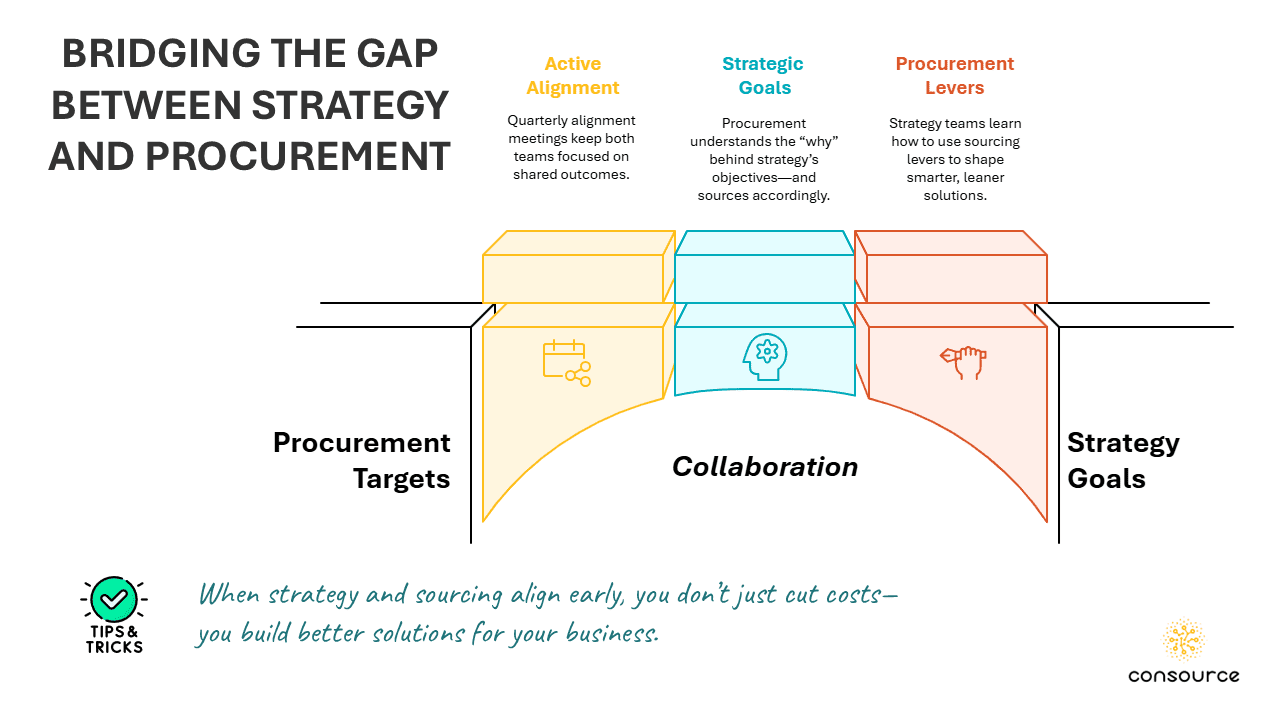
C. Faça da redução de custos um jogo de longo prazo
Economia única e chamativa? São ótimas para as manchetes. Mas elas raramente se mantêm.
A economia real ocorre quando:
- Você mede e compara o desempenho ao longo do tempo
- Você identifica padrões de sourcing repetíveis que geram eficiência
- Você aprende com os projetos anteriores (o que funcionou e o que não funcionou) e incorpora esse aprendizado na próxima rodada
Pense nisso como juros compostos: 2-3% mais inteligente, cada projeto soma milhões ao longo do tempo.
E o melhor? Quando as equipes percebem que a preocupação com os custos não significa "baixa qualidade", elas começam a participar, porque também percebem o valor.
A redução de custos não se trata apenas de fazer menos. Trata-se de fazer melhor, de forma mais inteligente e intencional - projeto após projeto.
V. Por que o Consource.io pode ser sua arma secreta
A esta altura, está claro: reduzir os custos de consultoria sem comprometer o valor exige mais do que habilidades de negociação ou um escopo inteligente.
Você precisa de visibilidade. Você precisa de estrutura. E você precisa de sistemas que apoiem uma tomada de decisão mais inteligente, mais rápida e mais transparente.
É exatamente aí que Consource.io brilha.
A. Visibilidade total de seus gastos com consultoria
Não há mais dados fragmentados em planilhas, e-mails ou pastas locais.
Com o Consource, você obtém:
- Um painel de controle centralizado que acompanha cada projeto, fornecedor e dólar gasto
- Filtros por região geográfica, unidade de negócios, categoria e muito mais
- Análise de despesas em tempo real para que você possa identificar tendências, vazamentos e oportunidades
Agora você pode responder às perguntas difíceis antes mesmo que as finanças as façam.
B. Processos de aquisição simplificados
Esqueça o envio e recebimento de PDFs por e-mail. O Consource estrutura todo o seu processo de aquisição de consultoria - sem torná-lo mais lento.
Com fluxos de trabalho automatizados, você pode:
- Lançar RFPs padronizadas
- Acompanhe as aprovações e validações
- Gerencie NDAs e assinaturas de contratos digitalmente
E sim, você pode fazer um escopo mais inteligente - sempre.
C. Desempenho e inteligência do fornecedor
Deseja saber quais empresas causam o maior impacto com o menor gasto?
O Consource oferece a você:
- Acompanhamento do desempenho pós-projeto
- Loops de feedback estruturados das partes interessadas
- Um banco de dados vivo de pontos fortes, taxas e resultados anteriores do fornecedor
É assim que você transforma "vamos usar essa mesma empresa novamente" em "vamos usar a direito firme, sempre".

D. Alinhamento estratégico, não silos
O Consource não é apenas para compras. Ele foi desenvolvido para conectar estratégia, sourcing e finanças - para que todos trabalhem com o mesmo manual.
Quando todas as partes interessadas operam a partir dos mesmos dados, com metas compartilhadas, você:
- Reduzir o atrito
- Acelerar a tomada de decisões
- Aumentar o ROI do projeto
E adivinhe só? É nesse momento que a redução de custos se torna sustentável, não dolorosa.
Conclusão: Economize com inteligência, ganhe muito
Reduzir os custos de consultoria não significa cortar custos.
Trata-se de reduzir o desperdício. Cortar o ruído. Cortar as coisas que atrapalham o impacto real.
Em um mundo em que os gastos com consultoria estão aumentando - mas o escrutínio está mais rigoroso do que nunca - você não precisa escolher entre economia e valor. Você só precisa de uma abordagem mais inteligente.
Isso começa com a compreensão do que você realmente está pagando.e o que você pode estar pagando sem perceber. Isso significa negociar resultados, não apenas horas. Definir o escopo dos projetos como um profissional. E gerenciar os consultores como parceiros, não como funcionários.
Mas, o mais importante, significa implementar os sistemas certos - para que você possa fazer tudo isso de forma consistente, entre equipes, regiões e tipos de projetos.
É aí que o Consource.io faz a diferença.
Com visibilidade em tempo real, inteligência de desempenho e fluxos de trabalho estruturados, ele transforma a aquisição de consultoria de uma disputa reativa em uma vantagem estratégica e proativa.
Portanto, a pergunta é a seguinte:
Você está pronto para reduzir os custos de consultoria, sem sacrificar os resultados?
👉 Reserve um passo a passo gratuito do Consource.io e descubra como a aquisição de consultoria mais inteligente começa hoje.

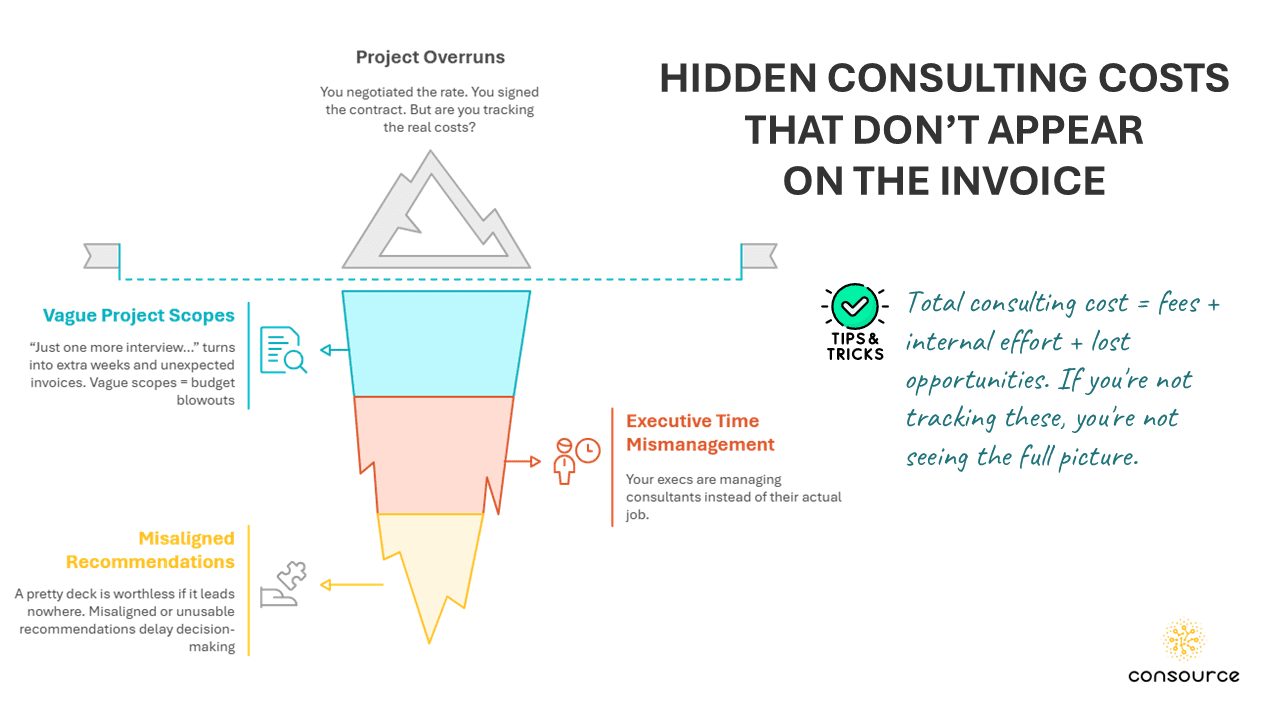
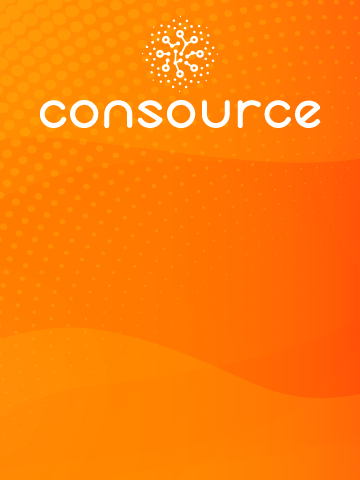




0 comentários